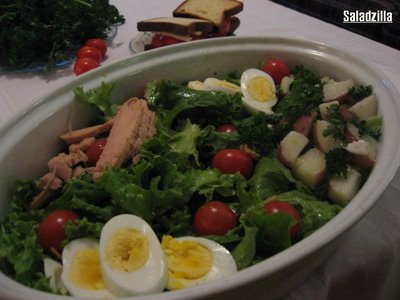Nothing against Chianti. I love those lusty Sangiovese-based wines, especially when it complements rich Italian sauces or other wonderful regional dishes that are centred around the tomato. It's just that no one ever seems to think it's desirable to serve other wines with tomato sauces. I'm here to say you can. In fact, sometimes you should.
Especially when you've got local superfresh tomatoes to work with -- like now, in September. Then you get the urge to make a cruda-inspired tomato sauce. Cruda style means minimal oil gets integrated into your farm-fresh vegetables. The veg cooks in its own natural juices and intensifies itself while it cooks (see my recipe at bottom). Naturally, cruda makes me think of a lighter-bodied, less opulent wine than the Sangiovese that a fine Chianti often features. Also, I think cruda sauces are less acidic than others. To be enjoyable, wine always has to have at least as much acid as your food. Since the acid in the sauce is going down, you can also scale down the acid content and choose a less acidic wine. Being low in acid is not something Chiantis are known for.
 So I dropped the Chianti Classico and instead served my fresh tomato sauce with a Cabernet Franc varietal from Saumur-Champigny and the regional Dão grapes of Portugal's Casa de Santar, which in 2003 produced a surprisingly sauve and smooth cuvée, made to order for a tomato sauce topped on a fresh white fish like tilapia. In the end, that's exactly how I decided to serve my sauce.
So I dropped the Chianti Classico and instead served my fresh tomato sauce with a Cabernet Franc varietal from Saumur-Champigny and the regional Dão grapes of Portugal's Casa de Santar, which in 2003 produced a surprisingly sauve and smooth cuvée, made to order for a tomato sauce topped on a fresh white fish like tilapia. In the end, that's exactly how I decided to serve my sauce.
THAT'S ITALIAN?
Here's how my homemade tomato sauce paired up with these two decidedly un-Italian wines. The 2003 Domaine du Ruault from the Loire was light but it still had very full flavour profile. I opened it first, so we drank it next to the appetizer course: homegrown orange cherry tomatoes (yes, more tomatoes!) on a garden salad. The Cabernet Franc lended the starter notes of licorice with vegetal and herbal underpinnings. It had some sharp edges, which made this wine coarser than the Chiantis I often drink. Nevertheless, with its tannic punch, it went on to measure up against the tomato sauce.
It was not long at that point until we opened the Dão. Casa de Santar Tinto 2003 had more body and was welcome as we continued on our main course. This Portuguese wine harmonized with the sauce well, supplying rounder fruit than the first and a lot more spice too. To me, this wine approximated a Chianti in an interesting way. Nice acidity. Definitely showing the rustic charm of Portugal yet conveying an Italian savouriness and an earthiness. Stewed prune notes harmonized with the tomato-bathed fish, which I served with a side of leeks and long-grain rice medley.
These two wines were prezzies from Ontario. The LCBO stocks them both and you cannot get either one in Quebec. Neither is in the general repertory section of the LCBO so you may need to research their availability a bit before you come across one. Locate Casa de Santar Tinto 2003 or Domaine du Ruault Saumur-Champigny 2003 before they sell out.
If you are successful, why not try them, especially the Dão, with my sauce. Here's the recipe, as promised.
Fresh tomato sauce
a half dozen large locally-grown tomatoes, the more bumps and surface blemishes the better
several sprigs of fresh garden basil, roughly chopped
an onion, in fine dice
three bay leaves
one tablespoon olive oil
sea salt and fresh pepper to taste
capers (optional)
chopped kalamata olives (optional)
Fill a
very large sauce pan, deep pot or dutch oven two-thirds full with salted water and bring it to a boil. Reduce heat to medium-low and immediately
blanch the tomatoes: Over a period of no longer than thirty seconds, submerge the tomatoes one-by-one and then fish each back out again.
Set aside the tomatoes,
green stem side down while you discard the water from your pot and return it to the stove. Add the tablespoon of olive oil to the pot and then begin to
soften the diced onion. Sprinkle with some salt and pepper. Reduce temperature further and stir if onions start to brown.
Using a
sharp blade, score a small cross at the blossom dimple.
Peel back the skin at each of the four corners you've created (While your tomatoes will already be in position to do this easily, you will find they are not too hot when handled carefully -- many cookbooks instruct that a bowl of ice cubes and water are necessary but I do not do this. As a result, you may get a bit more of the tomatoes on your fingers in peeling off the skins. This is because the internal cooking of the tomato was not halted by dunking it in cold water; however maintaining internal tomato structure is not important since we're making a sauce. And you'll love licking the delicious -- magenta, you'll notice -- and suddenly heightened-in-colour tomato goo off your fingers once you're done peeling anyway.)
Over a bowl or the pot,
halve or quarter your peeled tomatoes so that they are easier to hold. Then pick up and thinly slice each tomato directly into the pot. Add any juices you've accumulated in your bowl to the pot.
Bring it to a low boil and simmer for about 30 minutes.
After simmering the sauce, taste it to see how naturally sweet it is.
Add the chopped basil, along with salt and pepper to taste. Optionally, add capers or kalamata olives to inject some savour and
enhance the complexity of your sauce. Stir. (At this point, many cooks taste the sauce and then add more oil or red wine vinegar to give greater balance to a sweet sauce. Since fresh tomatoes we used give out more liquid -- and since we have plainly refused to waste the jelly, seeds and ribs that are often scooped out from the tomato and discarded...
why? -- adding more liquid ingredients at this stage will create the need for further reduction and dull the fresh basil flavour. As a result, I opt here for olives, instead of olive oil and capers instead of wine vinegar.)
Pour the sauce atop pasta, fish filets (tilapia, halibut, cod, wall-eye, etc), or grilled eggplant slices and serve.
QUICK FIX: If ever the sauce is still too liquid.Sometimes presentation is important to the dish you are serving your tomato sauce with. Sometimes you just can't wait for thickened sauce. Don't use a slotted spoon to let the runny juices behind.
Strain the entire pot through a fine mesh. Then use the remaining bright rust-coloured juice instead of a water bath to cook your fish filets. Or reserve it for boiling pasta on another night when don't feel like making a sauce but still would like a treat.

 The bottle that I'm writing about and that you see pictured here, was a prezzie I picked up in New York this summer. Tenuta Rapitalà Nuhar Nero d'Avola Cabernet Sauvignon 2003 is the bottle. (Nuhar appears as two words "Nu har" but apparently nuhar is the arabic for flower.) It's an affordable quaffer, but the nearly as much as its little brother is. That one is strictly a Nero d'Avola varietal and it is both less expensive and more expressive (a swell combo) and on sale locally (follow the link). The Nero d'Avola varietal from Rapitalà makes for a very enjoyable, distinctive wine, but I think I gravitate more to Rapitalà's Nero d'Avola blend. I love Nero d'Avola to be sure, but it can hit rough patches and end up lacking some smoothness.
The bottle that I'm writing about and that you see pictured here, was a prezzie I picked up in New York this summer. Tenuta Rapitalà Nuhar Nero d'Avola Cabernet Sauvignon 2003 is the bottle. (Nuhar appears as two words "Nu har" but apparently nuhar is the arabic for flower.) It's an affordable quaffer, but the nearly as much as its little brother is. That one is strictly a Nero d'Avola varietal and it is both less expensive and more expressive (a swell combo) and on sale locally (follow the link). The Nero d'Avola varietal from Rapitalà makes for a very enjoyable, distinctive wine, but I think I gravitate more to Rapitalà's Nero d'Avola blend. I love Nero d'Avola to be sure, but it can hit rough patches and end up lacking some smoothness.






























